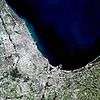Crystal Lake, Illinois
Crystal Lake is a city in McHenry County in the U.S. state of Illinois. Named after a lake 1.6 miles (2.6 km) southwest of the city's downtown, Crystal Lake is 45 miles northwest of Chicago.[4] The population was estimated at 39,829 in July 2019, a 2.3% decrease from 2010.[5] Crystal Lake is the largest city in McHenry County, part of the Chicago metropolitan area.[6]
Crystal Lake "CL" (Nickname) "A Good Place to Live" | |
|---|---|
City | |
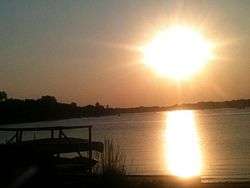 Sunset over Crystal Lake's namesake lake | |
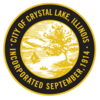 | |
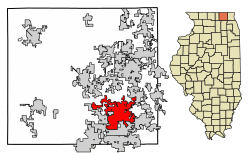 Location of Crystal Lake in McHenry County, Illinois | |
.svg.png) Location of Illinois in the United States | |
| Coordinates: 42°13′35″N 88°20′8″W | |
| State | Illinois |
| County | McHenry County |
| Townships | Algonquin, Dorr, Nunda, Grafton |
| Adoption of city charter | September 23, 1914 |
| Government | |
| • Type | Mayor-council |
| • Mayor | Haig Haleblian (acting) |
| Area | |
| • Total | 19.53 sq mi (50.58 km2) |
| • Land | 18.91 sq mi (48.99 km2) |
| • Water | 0.61 sq mi (1.59 km2) |
| Elevation | 942 ft (287 m) |
| Population (2010) | |
| • Total | 40,743 |
| • Estimate (2019)[2] | 39,829 |
| • Density | 2,105.79/sq mi (813.05/km2) |
| Time zone | UTC−6 (CST) |
| • Summer (DST) | UTC−5 (CDT) |
| ZIP Code(s) | 60012, 60014, 60039 |
| Area code(s) | 815, 779 |
| FIPS code | 17-17887 |
| Home value: | $186,157 (2013)[3] |
| Wikimedia Commons | Crystal Lake, Illinois |
| Website | www |
History
Founding
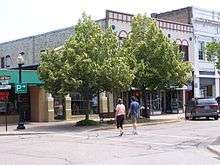
The City of Crystal Lake traces its origin to two separate communities which were established in the 1800s. Those communities were generally known as Nunda and Crystal Lake. In 1835, Ziba S. Beardsley had come to the shores of the lake and commented that the "waters were as clear as crystal", thereby giving the lake its name. Ziba Beardsley continued south to Naperville. In February 1836, the first white settlers, Beman and Polly Crandall and six of their ten children, came from New York State traveling to Crystal Lake in a covered wagon. Their original cabin was built in the vicinity of today's intersection of Virginia Street and Van Buren Street. Four of the Crandall children were born there. Najah Beardsley's family was the second to settle in the area; his grandson, William Beardsley, was the first white child born on the Crystal Lake prairie, on May 7, 1837.[7]
The town was first known as Crystal Ville. It was changed to Crystal Lake sometime before 1840. The area known today as downtown Crystal Lake was first called Dearborn and later, Nunda, from an area in New York where many settlers originated. The village of Dearborn was founded in the 1850s after an extension of railroads through the area. The first train station was built in 1856, although it was pre-fabricated and shipped from Chicago on a flatcar. At that time, the main business district for the village of Crystal Lake was located on Virginia Street, about one mile (1.6 km) southwest of the railroad station. The railroad served to connect both the people and industries of Crystal Lake and Dearborn to Chicago and the rest of the country. Dearborn grew quickly due to this new rail connection.
On October 7, 1868, Dearborn's name was changed to Nunda. The village was platted in 1868 by local surveyor, John Brink, after whom a downtown street is now named. The village included the area now generally bounded by Illinois Route 176 on the north, Crystal Lake Avenue on the south, Main Street on the east, and Walkup Avenue on the west. Much of the land was originally owned by two early settlers, Daniel Ellsworth and Simon S. Gates. The villages of Crystal Lake and Nunda were both incorporated in 1874. In 1908, the name of the village of Nunda changed its name to North Crystal Lake. Several attempts were made to consolidate the two villages, and finally, after much disagreement, the village of North Crystal Lake was annexed to the Village of Crystal Lake in 1914, and a consolidated city government was established.[8]
Dole family
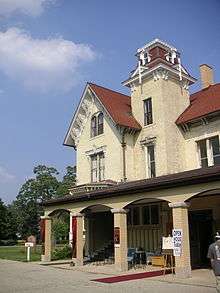
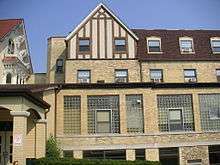
Back in the 1860s, when the town of Crystal Lake was about 25 years old, Charles S. Dole purchased over 1,000 acres (4.0 km2) of land overlooking the lake. It was his dream to construct an elaborate estate that would reflect his position as a successful businessman. He was an early member of the Chicago Board of Trade, being associated with Armour, Dole & Co. in Chicago. To carry out his plan, he built a three-story mansion with adjoining gardens and stables. European craftsmen were imported to lay parquet floors, fashion archways and carve interior wood work from black walnut trees grown on the property. As a final touch, he brought in Italian artisans to build several marble fireplaces. According to Mr. Dole's obituary, construction costs exceeded $100,000, an enormous amount of money in those days.[7]
The estate was known as Lakeland Farm. Mr. Dole lived there with his wife Julia, his mother-in-law, Mrs. Harriet Coffin, his two daughters, Mary Florence, Harriet (Hattie), and son, Sydney. Dole maintained the estate for over 30 years, entertaining lavishly. As an example, for his daughter's wedding in 1883 he built a spur line from the Chicago and Northwestern railway tracks almost to his doorstep. A canopied and carpeted walkway extended 750 feet (230 m) from the front door to the train enabling the guests to walk to the mansion for the ceremony and return to the train without concern for the weather. Notable wedding guests included Julian Rumsey (mayor of Chicago and Dole's first cousin) and Levi Leiter (first partner with Marshall Field).
Mr. Dole's interests changed throughout the years. He laid out a half-mile racetrack on his property and purchased the finest horses that money could buy, soon accumulating a string of horses that was the envy of northern Illinois. It is said that Dole loved to go up in his tower (currently closed off) and watch his horses run. When tired of the fad of his stable, he disposed of his horses by holding an elaborate sale. The Doles lived in the mansion until the late 1890s when the property was sold to his son in law for $1.00.
During the early 1900s, the property was owned and operated by several different ice companies. Ice was harvested from Crystal Lake and shipped by rail to nearby Chicago. The advent of refrigeration brought about the decline of the ice business. After laying vacant for several years, the property was sold in 1922 to the Lake Development Company. Today the Dole Mansion is owned by the Lakeside Legacy, along with Lakeside center, which is the building connected to the Dole Mansion. Dole Mansion is located along the lake, and there is a festival held on the grounds every year.
Eliza Ringling
Ringling Road is an east-west road which curves from Country Club Road back up to Lake Avenue. There are less than one dozen houses that claim a Ringling Road address; but those houses range from a small, stone cottage to large, imposing mansions. It is no mistake that Ringling Road provides the northern boundary for the Dole Mansion property. The road was named after Eliza "Lou" Ringling who, as founder of the Lake Development Company, purchased the Dole Mansion in 1922 and converted it into the first Crystal Lake Country Club. The transaction involved nearly a half million dollars and was one of the largest real estate deals handled in the area. The original Crystal Lake Country Club faltered in the stock market crash of 1929, and Mrs. Ringling, with her group of investors (the Lake Development Company) subdivided much of the large Dole estate into what is known as the Country Club Additions subdivision[9] parts of which are in the neighboring village Lakewood, Illinois.
Eliza "Lou" Ringling was the widow of the oldest Ringling brother, Albert, of circus fame.[9]
Teco pottery
The American Terra Cotta Tile and Ceramic Company was founded in 1881[10] just north of Crystal Lake, Illinois. Most of the workers at the tile and ceramic works factory came from Crystal Lake,[11][12] The production consisted of drain tile, brick and architectural items. In 1886 the Gates Pottery was established as a subsidiary with William D. Gates, a Crystal Lake area native[11] as its president. The company fabricated architectural glazed terra cotta that was used on buildings designed by architects Louis Sullivan and Frank Lloyd Wright in the style of the Prairie School. American Terra Cotta's company records[13][14] show that architectural glazed terra cotta was used on many local buildings including Oak Manufacturing Company, Teckler Building, Cohn Store, Telephone Exchange and Commercial Building, El-Tovar Theatre, Crystal Lake High School and additions, Central School and additions, Pure Oil Research Lab and additions, Sinclair Refining Company Service Station, Warner Building, Citizens State Bank, Garbe Garage, Home State Bank, various Williams Street stores and bakeries, and Martinetti's Motel.
Gates used the facilities to experiment with clays and glazes in an effort to design a line of art pottery which led to the introduction of Teco pottery (from TErra COtta, but pronounced locally as "Tea-co") in 1902. Many of the pottery pieces were designed by architects such as Frank Lloyd Wright[15] Produced for only a few years, this pottery exemplifies the Arts and Crafts Movement and today is highly sought after by art collectors. Teco pottery is in the collection of many museums.[16]
Recent history
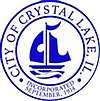
On April 11, 1965, during the Palm Sunday tornado outbreak, a large and devastating tornado damaged or destroyed large portions of the city. Six people were killed by the tornado, and a further 75 wounded. Damages in the city totaled over $1.5 million, as 80 homes and a shopping center were completely destroyed. Disaster shelters were set up to house the homeless, and then-governor of Illinois, Otto Kerner, Jr., personally visited the city to view the damage.[7]
In the past 20 years, the history of Crystal Lake has consisted mainly of the growing of suburban subdivisions, as the population increased to 38,000 in the 2000 Census from 21,823 in the 1990 Census. In order to deal with the growth, Crystal Lake South High School was opened in 1978. Previously, Crystal Lake Community High School (now Crystal Lake Central High School) had served the entire city of Crystal Lake since 1924. Even more recently a third high school, Prairie Ridge High School, opened in 1997 north of the city to accommodate the spread moving into the area between Crystal Lake and the two communities directly to its north, Prairie Grove and Bull Valley.
Some challenges currently facing the city of Crystal Lake include a large and sudden increase in immigration, and an inconvenient road system leading to frequently snarled traffic. However, the overall quality of life and education in the city remains quite high. In addition, a robust city park system and continued revitalization of the downtown area, including a new city hall, have continued to make Crystal Lake an attractive community for new residents. Another positive note for the city is that Crystal Lake is the city where the tradition of giving gold coins to the Salvation Army anonymously began in 1982.[17]
The Raue Center for the Arts, in the downtown district, has distinguished itself as a regional and national tourism draw. The National Piano Conference has been held in the Raue Center since 2012.
In 2015, Crystal Lake was ranked tenth best city among 1,268 U.S. cities with populations between 25,000 and 100,000 by WalletHub.[18][19][20]
In 2016, it was reported that there were zero retail vacancies in the downtown district of Crystal Lake.[21] This was the case until 2017.
Crystal Lake Park District
The Crystal Lake Park District, a separate elected governing body not associated with the city, offers in excess of 40 parks (totaling over 2,000 acres) and recreation areas. Notable parks maintained by the Park District include the 140 acre Veteran Acres Park and Lippold Park, the largest single park in the district at 305 acres. Lippold Park has played host to the McHenry County Youth Sports Association Summer International 15-year-old Baseball Championships for the past 22 years, drawing teams from across the United States and Puerto Rico as well as from Japan, Brazil, and other countries. The Park District also owns and operates 2 beach parks located on the city namesake Crystal Lake and also maintains Illinois Nature Preserve land and the Col. Palmer House a historic landmark and home of the first settler in the area. Additionally, the district operates The Racket Club, an indoor/outdoor tennis facility that has 9 indoor courts. The facility is operated as an Enterprise Fund meaning that it is totally self-supporting with no tax dollars going towards it in any manner.[22]
Geography
According to the 2010 census, Crystal Lake has a total area of 18.957 square miles (49.10 km2), of which 18.35 square miles (47.53 km2) (or 96.8%) is land and 0.607 square miles (1.57 km2) (or 3.2%) is water.[23]
Neighborhoods
As the largest city in McHenry County, Crystal Lake contains three high schools and has many separate neighborhoods.
Starting from the north of the city, the ten largest neighborhoods are easy to trace out. The first has no de facto name like the others, but is referred to as "by Prairie Ridge," referring to the nearby high school of the same name. Houses in this neighborhood are large and widely spaced. The entire area lies just to the north of the city, from the downtown area to the adjacent community of Bull Valley. Some of the communities include Deer Wood, Covered Bridge Trails and Walk-up Woods. Next is downtown Crystal Lake, which rings Crystal Lake Central High School. Houses here range greatly in size and age, and it is the most diverse neighborhood in the city. Directly south of downtown Crystal Lake is the Coventry neighborhood, named for the major through street Coventry Lane. Students in the Coventry neighborhood attend either Central High School of Crystal Lake or Crystal Lake South High School. Oral tradition holds that Coventry was originally populated by pilots who fly out of O'Hare Airport. The neighborhood Burtons Bridge is located at the north-eastern side of Crystal Lake.
To the southwest of downtown Crystal Lake is the sprawling Four Colonies neighborhood, which covers nearly 2.5 sq mi (6.5 km2). Students from Four Colonies attend both Central and South High School. South of Four Colonies is The Villages neighborhood, which is named for its major thoroughfare, Village Road. An important feature of The Villages is Indian Prairie Elementary School, which is built on a large and steep series of hills that is a favorite sledding location during the snowy months. The residents attend South High School. A neighborhood Northeast of Four Colonies is Wedgewood. Wedgewood includes five ponds, and a forest that backs up to Huntley Road, with a paved walking path. Wedgewood has five brick entrance signs saying "Wedgewood", and 3 prominent entrances; the front entrance on Huntley Road's intersection with Lakeview Drive, the back entrance on Huntley Road's intersection with Boneset Drive, and the side entrance on Country Club Road. Wedgewood consists of single family homes and multi-family dwellings such as townhouses. Wedgewood Drive circles the whole neighborhood, and is a 1½-mile circle.[24]
Other neighborhoods in Crystal Lake ring the town's namesake lake, and are called West End, North Shore, and the Vista. These neighborhoods consist of many older homes built on the lake shore, and vary greatly in size and style. Effectively a neighborhood and occupying the entire south shore of the lake is the independent Village of Lakewood, historically a restricted community connected strongly to the Crystal Lake Country Club alongside it.
There are also numerous smaller subdivisions found in various spots around the city.
Climate
The city's climate is much like that of its large neighboring city, Chicago. The city experiences hot summers and cold winters, with temperatures slightly more extreme than those of closer suburbs, because rural land still surrounds the city. Due to the lack of the urban heat island effect, Crystal Lake experiences colder nights and lower precipitation than recorded at Chicago. High temperatures are usually comparable to those in Chicago, with only a few degrees difference on most days.
The hottest month of the year is July, when the average high temperature is approximately 86 °F (30 °C). Temperatures in July, and in summer in general, can frequently exceed 95 °F (35 °C), and occasionally exceed 100 °F (38 °C), although this does not happen each year. The coldest month of the year is January, where the average high temperature is 23 °F (−5 °C). Overnight low temperatures are usually around 8 °F (−13 °C). In winter, the low temperatures fall below 0 °F (−18 °C) on many (often as many as fifteen or twenty) occasions per year. Extremely cold nights may record temperatures as low as −20 °F (−29 °C) or lower, but this is rare and does not happen each year.[7]
The wettest month of the year is August, when thunderstorms contribute brief, heavy downpours of rain. July is the second-wettest month of the year, also mainly due to thunderstorms. However, long dry spells can also occur at this time of year, sometimes lasting weeks. The two driest months of the year are January and February, where almost all of the precipitation falls as snow. In a typical year, total precipitation is 37 inches (940 mm) with a winter snowfall total of 40 inches (1,000 mm). Large snowstorms, although rare, do occur and can accumulate large amounts of snow. In many years, at least one storm will deliver 12 inches (300 mm) of snow in one day. Most snow-bearing systems are Alberta clippers, while the more infrequent heavy snows are caused by Panhandle hooks.
Climate data for Crystal Lake, Illinois, 1981–2010 normals, extremes 1849–present | |||||||||||||
|---|---|---|---|---|---|---|---|---|---|---|---|---|---|
| Month | Jan | Feb | Mar | Apr | May | Jun | Jul | Aug | Sep | Oct | Nov | Dec | Year |
| Record high °F (°C) | 62 (17) |
70 (21) |
82 (28) |
91 (33) |
92 (33) |
101 (38) |
101 (38) |
98 (37) |
95 (35) |
89 (32) |
75 (24) |
67 (19) |
101 (38) |
| Average high °F (°C) | 28 (−2) |
33 (1) |
44 (7) |
58 (14) |
69 (21) |
79 (26) |
83 (28) |
81 (27) |
74 (23) |
62 (17) |
46 (8) |
33 (1) |
58 (14) |
| Daily mean °F (°C) | 20 (−7) |
25 (−4) |
35 (2) |
47 (8) |
58 (14) |
68 (20) |
73 (23) |
71 (22) |
63 (17) |
51 (11) |
38 (3) |
25 (−4) |
48 (9) |
| Average low °F (°C) | 11 (−12) |
16 (−9) |
26 (−3) |
36 (2) |
47 (8) |
57 (14) |
62 (17) |
60 (16) |
51 (11) |
40 (4) |
29 (−2) |
17 (−8) |
38 (3) |
| Record low °F (°C) | −27 (−33) |
−22 (−30) |
−8 (−22) |
11 (−12) |
28 (−2) |
36 (2) |
45 (7) |
40 (4) |
29 (−2) |
18 (−8) |
−7 (−22) |
−24 (−31) |
−27 (−33) |
| Average rainfall inches (mm) | 1.68 (43) |
1.38 (35) |
2.23 (57) |
3.91 (99) |
3.84 (98) |
4.31 (109) |
3.93 (100) |
4.43 (113) |
3.63 (92) |
2.66 (68) |
3.12 (79) |
2.1 (53) |
37.22 (945) |
| Average snowfall inches (cm) | 10.2 (26) |
7.3 (19) |
4.5 (11) |
1.1 (2.8) |
— | 0.0 (0.0) |
0.0 (0.0) |
0.0 (0.0) |
0.0 (0.0) |
0.1 (0.25) |
1.5 (3.8) |
9.8 (25) |
34.5 (88) |
| Source 1: http://www.intellicast.com/Local/History.aspx?location=USIL0280 | |||||||||||||
| Source 2: https://w2.weather.gov/climate/xmacis.php?wfo=lot | |||||||||||||
Government
See the full article, List of mayors of Crystal Lake, Illinois
Mayor
Haig Haleblian (acting)
City council
The city council consists of Ellen Brady Mueller, Cathy A. Ferguson, Cameron Hubbard, Brett Hopkins, and Haig Haleblian.[25]
City clerk
Nick Kachiroubas is the City Clerk in Crystal Lake.[25]
Demographics
| Historical population | |||
|---|---|---|---|
| Census | Pop. | %± | |
| 1880 | 546 | — | |
| 1890 | 781 | 43.0% | |
| 1900 | 950 | 21.6% | |
| 1910 | 1,242 | 30.7% | |
| 1920 | 2,249 | 81.1% | |
| 1930 | 3,732 | 65.9% | |
| 1940 | 3,917 | 5.0% | |
| 1950 | 4,832 | 23.4% | |
| 1960 | 8,314 | 72.1% | |
| 1970 | 14,541 | 74.9% | |
| 1980 | 18,590 | 27.8% | |
| 1990 | 24,512 | 31.9% | |
| 2000 | 38,000 | 55.0% | |
| 2010 | 40,743 | 7.2% | |
| Est. 2019 | 39,829 | [2] | −2.2% |
| U.S. Decennial Census[26] | |||
As of the 2010 Census,[27] there were 40,743 people, 14,421 households, and 10,551 families living in the city. The population density was 2,220/sq mi (857/km2).[28] There were 15,176 total housing units and 22% of all housing units were in multi-unit structures. The racial makeup of the city was 90.2% White, 1.0% Black or African American, 0.4% Native American, 2.5% Asian, <0.01% Pacific Islander, 4.1% from other races, and 1.8% from two or more races. Hispanic or Latino of any race were 11.7% of the population.
39.2% of the households included children under 18, 58.9% were married couples living together, 10.1% had a female householder with no husband present, and 26.8% were non-families. 22.1% of all households were made up of individuals living alone and 20.3% had someone at least 65 years old living alone. The average household size was 2.81 and the average family size was 3.31.
In the city, the population was spread out with 28.1% under the age of 18, 8.% from 18 to 24, 26.2% from 25 to 44, 27.7% from 45 to 64, and 10.0% who were 65 years of age or older. The median age was 37 years. For every 100 females, there were 97.6 males.
The median income for a household in the city was $78,311, and the median income for a family was $91,870. Males had a median income of $61,982 versus $44,288 for females. The median income for the city was $36,405. About 5.2% of families and 6.2% of the population were below the poverty line, including 9.1% of those under age 18 and 5.3% of those age 65 or over.[29]
In 1990, the population of Latinos (Hispanics) was at 0.1%.[30] Per the 2000 US Census, the Latino population increased to 7% and per the 2010 US Census, the Latino population is now 11.7%.[28]
Culture and sites of interest
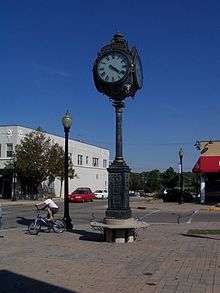
Crystal Lake, as a city, is large enough to entertain its cultural institutions. However, it also shares many cultural opportunities with the city of Chicago, and the other large communities which surround it, as they are easily accessible from Crystal Lake, and vice versa. The city is home to the Northwest Herald, the only daily newspaper published in McHenry County. The newspaper deals mainly with local issues, but also carries national and world news. Churches are also a large influence within the city, hosting many annual events. Crystal Lake is also home to WZSR Star 105.5, owned by Alpha Media, which broadcasts throughout the northwest suburbs and Fox Valley.[7]
Another large presence in the city is the Crystal Lake Park District, which runs all of the city's numerous parks and the yearly events which take place within them. Two major parks run by the park district are Veterans Acres, along Walkup Road, and Main Beach, along with the namesake Crystal Lake. Crystal Lake is open whenever the weather is accommodating. However, boating is often restricted due to disputes with both the homeowners on the lake and the village of Lakewood, in which approximately 30% of the lake lies. The Crystal Lake Rowing Club has a boathouse in Kamijima Park, on the west end of Crystal Lake, and rows on the lake during the no-wake hours (usually early mornings and early evenings). In Crystal Lake lies the famed Dole mansion, where visitors can take tours for a small donation.
Among the city's sites of interest is the historic downtown district. The downtown district, which recently has undergone a revitalization, is home to many small specialty shops and businesses, and is a local shopping district. Also located in the downtown district is the Raue Center for the Arts, which seats 750 and performs plays and hosts concerts throughout the year. Raue Center has recently transformed itself into a regional destination spot by providing an in house professional theater company, Williams Street Repertory, Jazz Festival launched by Ramsey Lewis and hosting several recent Tony, Grammy, and Academy award winners. The Raue Center has received four MacArthur Grants and regularly receives National Endowment for the Arts support. The city is also home to the Crystal Lake Strikers, Crystal Lake Community Band, McHenry County Music Center and Voices in Harmony (formerly known as the Crystal Lake Community Choir).
The Col. Gustavus A. Palmer House is a historic residence in Crystal Lake, being constructed in 1858.
Economy
The economy of Crystal Lake is fairly decentralized, as there is no central industry within the city. There are several large companies, but none of them is a majority employer. The main economic activities in the city are retail, dining, and light industry. This includes small, specialized, local-owned shops and restaurants as well as broader-ranged national chains. There are several industrial parks in Crystal Lake, which are full of small, independently-owned businesses which engage in various industries, such as landscaping or automotive repair.
The shopping center for most of Crystal Lake centers on "the strip", a long stretch of road that runs along what once used to be Crystal Pointe Mall but is now a series of strip malls. The strip is located on Route 14 between Route 31 and Dole Avenue. As the name suggests, this area has mostly national chains. Another shopping area is the downtown district, which is where some, small independent stores are located. Because of parking challenges in the downtown area, many thriving independent businesses can be found in convenient areas throughout the city where access for their customers is more centralized and parking is more abundant.[7]
If any particular industry could be called prevalent, the city of Crystal Lake has several car dealerships, and the south side of the city features several gravel quarries.
The majority of these quarries are already exhausted, and have been allowed to fill with water, forming an area known as the Vulcan Lakes, also stretching into Lake in the Hills and Algonquin. The two northernmost lakes are now known as Three Oaks Recreation Area. Recreational operations at this site started in Autumn, 2010, and it has since become one of the most popular destinations in Crystal Lake.[31]
An approval for a hospital for Crystal Lake was given by the board in Springfield, but has since met opposition. Illinois State law forbids the construction of new hospitals with less than 100 beds. The proposed Crystal Lake Hospital would hold 80-95 beds and be run by a Wisconsin corporation. Opposition from hospitals in Lake Barrington, Woodstock, McHenry, and Elgin were immediately voiced and it remains to be seen just when the hospital will be built.
Education
The city of Crystal Lake high schools are in a different school district than the middle schools and elementary schools. High schools in the city are run by Community High School District 155, which runs four high schools, including all three in the city of Crystal Lake. Crystal Lake Community Consolidated School District 47 runs all middle schools and elementary schools in the city of Crystal Lake. Prairie Grove Consolidated School District #46 also serves a portion of northeast Crystal Lake.
There are five high schools which serve the city of Crystal Lake. The oldest, Crystal Lake Central High School (Central for short), graduated its first class in 1924 and was known as Crystal Lake Community High School when it opened. It is located in the downtown area of the city, and has an enrollment of approximately 1600. This school serves Crystal Lake and Lakewood, as well as the far west side of Huntley and southwestern Woodstock. In response to pressures from increasing population, Crystal Lake South High School (South for short), was opened in 1978. When it was completed, the school was ridiculed for being remotely located and surrounded by corn fields. It now stands boxed in by suburban development. Prairie Ridge High School (often simply called PR) opened in the fall of 1997, again due to increasing population pressure. The school stands on a hill off to the north of the city. The school serves mostly students who live in the 60012 and northern/eastern 60014 ZIP code areas of Crystal Lake, as well as Prairie Grove, Ridgefield, Oakwood Hills, and Burtons Bridge. They also serve some students who live in Cary, Woodstock, McHenry and Bull Valley. A very small portion of far-eastern Crystal Lake is served by Cary-Grove High School, which opened in 1961. It's located all the way in Cary, Illinois, and has an enrollment of approximately 1795. Students who live on the far east side of Crystal Lake attend Cary-Grove. The school also serves Cary, Fox River Grove, Barrington, Trout Valley, and Oakwood Hills as well. Lastly for public schools a very small portion of western Crystal Lake is served by Woodstock High School. Also located in Crystal Lake is Faith Lutheran High School which serves the larger McHenry County area.
Crystal Lake is home to ten elementary schools and three high schools. Three of the elementary schools have been constructed since 1990 due to the increasing expansion of suburban developments. The names of the ten elementary schools include:
- Canterbury (named after the Coventry subdivision)
- Coventry (named after the Coventry subdivision)
- Glacier Ridge
- Husmann (named after a long-time principal, formerly called "Central" and the oldest elementary)
- Indian Prairie
- North (adjacent to Bernotas Middle School campus)
- South (adjacent to Lundahl Middle School campus)
- West (at west end of Crystal Lake itself)
- Woods Creek
- Prairie Grove
There are four middle schools in Crystal Lake:
- Bernotas (Formerly North Junior High, now named after a longtime principal) was built as North Junior High in 1969 and in 2003, the board of education approved a name change to Richard F. Bernotas Middle School-North Middle Campus.[32] Bernotas Middle School's mascot is Thor, represented by a Viking, which is also RFB's name for its sports team. Most Students who attend Bernotas later attend Crystal Lake Central High School, and some later attend Crystal Lake South High School or Prairie Ridge High School.
- Hannah Beardsley, which opened in 1996 and is named after the first school teacher in Crystal Lake. Its mascot is the bear, and its colors are orange and blue. Most students who attend Hannah Beardsley later attend Prairie Ridge High School, and some later attend Crystal Lake Central High School or Crystal Lake South High School.[33]
- Lundahl (Formerly South) was built as South Middle School during 1958–1959. It opened in 1959, and in 1966, the name was changed to Leon J. Lundahl Jr. High School, in honor of Leon J. Lundahl, former Superintendent of Schools for District 47.[34] Also Lundahl Junior High School became an accredited middle school in the spring of 1995 and the name was officially changed to Lundahl Middle School Campus for the opening of the 1996-97 school year. Most students who attend Lundahl later attend Crystal Lake South High School, and some later attend Crystal Lake Central High School.[34]
- Prairie Grove Junior High School was built in 1998 and opened in 1999 which is the newest Middle School in Crystal Lake. It also serves its very own district known as District 46. Prairie Grove is home to the Panthers. Most students who attend Prairie Grove later attend Prairie Ridge High School.[35]
Additional schools serving Crystal Lake include Lord and Savior Lutheran School,[36] a Pre-K-8 grade school of the Wisconsin Evangelical Lutheran Synod in Crystal Lake, St. Thomas the Apostle, a private Roman Catholic school that serves Pre-K through eighth grade, also in Crystal Lake,[37] Immanuel Lutheran School, a private Lutheran school that serves Pre-K through eighth grade, also in Crystal Lake,[38] Alexander Leigh Center for Autism in McHenry, a full day, year-round therapeutic day school for children 3–21 years old with autism spectrum disorder, OHI, multiple disabilities, developmental delay and/or intellectual disabilities,[39] and the School of Expressive Arts & Learning campus in Woodstock for those with learning disorders and autism spectrum disorder.
Additionally, there are two colleges in Crystal Lake: McHenry County College, a community college, offers associate degrees. Columbia College also has an extension campus based in Crystal Lake.[40]
Public transportation
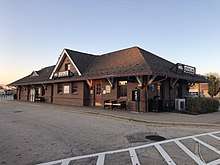
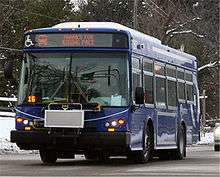
Crystal Lake is located 50 miles (80 km) northwest of Chicago, is about a 45-minute drive from O'Hare International Airport, and is near several major highways and interstates.[41] The Metra Rail Union Pacific Northwest Line provides transportation to and from Chicago, and all other stations on Metra's Northwest Line. Taxi service in Crystal Lake is provided by the Crystal Lake Cab Company,[42] Crystal Lake Taxi Services, and American Dependable.[43] Also serving Crystal Lake is the Pace Bus system,[44] which is the owned by the RTA (Regional Transit Authority).
Sister cities

Notable people
See also
References
- "2019 U.S. Gazetteer Files". United States Census Bureau. Retrieved July 14, 2020.
- "Population and Housing Unit Estimates". United States Census Bureau. May 24, 2020. Retrieved May 27, 2020.
- "Crystal Lake, Illinois (IL 60014) profile: population, maps, real estate, averages, homes, statistics, relocation, travel, jobs, hospitals, schools, crime, moving, houses, news, sex offenders". City-data.com. Retrieved 2016-03-07.
- "Crystal Lake Homes For Sale". Illinoisrealestate.com. Retrieved 2015-03-30.
- "US Census Bureau QuckFacts". USCB. Retrieved 13 June 2019.
- "Chicago Metropolitan Agency for Planning". CMAP. Retrieved 27 April 2011.
- "History of Crystal Lake". City of Crystal Lake. 2009. Archived from the original on 2010-05-13. Retrieved 2009-12-16.
- "Early History - Crystal Lake Historical Society". Cl-hs.org. 2015-03-21. Archived from the original on 2015-04-02. Retrieved 2015-03-30.
- "Street Scenes : Ringling Road" (PDF). Cl-hs.org. Archived from the original (PDF) on 2015-09-23. Retrieved 2015-03-30.
- "Northwest Architectural Archives,University of Minnesota". Special.lib.umn.edu. Retrieved 2010-07-28.
- Darling, Sharon S.; Zakin, Richard (1989). Teco: Art Pottery of the Prairie School. Erie, Pa: Erie Art Museum. ISBN 978-0-9616623-2-5. OCLC 20056198.
- Berry, George A.; Darling, Sharon S. (2003). Common Clay: A History of American Terra Cotta Corporation, 1881–1966. Crystal Lake, Illinois: TCR Corp. ISBN 978-0-9747738-0-3. OCLC 55023086.
- "Northwest Architectural Archives N5, University of Minnesota Libraries, Minneapolis, Minnesota American Terra Cotta and Ceramic Company Records". Retrieved 2016-08-23.
- Kenney, Diana L. (2009). Crystal Lake Postcard History Series. Charleston, South Carolina: Arcadia Pub. ISBN 978-0-7385-6007-6. OCLC 466906597.
- Darling, Sharon S.,Teco Art Pottery of the Prairie School
- "Chicago History Museum | Decorative and Industrial Arts". Chicagohistory.org. Archived from the original on 2010-08-23. Retrieved 2010-07-28.
- Chicago Tribune, 2013-12-08, Page 3
- Connolly, Colleen (2015-11-03). "Crystal Lake, Algonquin Ranked in 'Best Small Cities' Report". NBC Chicago. Retrieved 2016-03-07.
- "Northwest Suburb Named One of the Best Small Cities in America". nbcchicago.com. November 13, 2015. Retrieved July 27, 2016.
- Craver, Kevin (June 14, 2016). "WalletHub Ranks Crystal Lake in Top 10 for Best Small Cities in America". Northwest Herald. Retrieved July 27, 2016.
- Linhart, Nate (July 26, 2016). "Downtown Crystal Lake Has No Retail Vacancies". Northwest Herald. Retrieved July 27, 2016.
- "Veteran Acres Park | Crystal Lake Park District". Crystallakeparks.org. Archived from the original on 2015-03-26. Retrieved 2015-03-30.
- "G001 - Geographic Identifiers - 2010 Census Summary File 1". United States Census Bureau. Archived from the original on 2020-02-13. Retrieved 2015-12-27.
- "New Residents". Crystal Lake. 2009-02-03. Archived from the original on 2010-08-14. Retrieved 2010-07-28.
- "City Council". Crystallake.org. Retrieved May 7, 2020.
- "Census of Population and Housing". Census.gov. Retrieved June 4, 2015.
- "Profile of General Population and Housing Characteristics: 2010". United States Census Bureau. Archived from the original on 2020-02-13. Retrieved 2017-10-09.
- "Crystal Lake (city) QuickFacts from the US Census Bureau". Quickfacts.census.gov. Archived from the original on 2015-04-17. Retrieved 2015-03-30.
- "U.S. Census website". United States Census Bureau. 2010-10-05. Retrieved 2015-03-30.
- "1990 Census". Census.gov. Retrieved 2010-07-28.
- "City of Crystal Lake Annual Budget 2010-2011". crystallake.org. Archived from the original on 2010-12-14. Retrieved 2010-12-27.
- "Crystal Lake School District 47 - Richard Bernotas Middle School - History". D47.org. Archived from the original on 2011-07-25. Retrieved 2010-07-28.
- "Crystal Lake School District 47 - Hannah Beardsley Middle School - History". D47.org. Archived from the original on 2011-07-25. Retrieved 2010-07-28.
- "Crystal Lake School District 47 - Lundahl Middle School - History". D47.org. Archived from the original on 2011-07-25. Retrieved 2010-07-28.
- "Consolidated School District 46 - Prairie Grove Junior High". Dist46.org. Archived from the original on 2011-07-26. Retrieved 2010-07-28.
- "Who We Are".
- "Kindergarten - Elementary - Middle - St. Thomas School". stthomascl.org. Retrieved 21 July 2016.
- "Immanuel Lutheran Crystal Lake". immanuelcl.org. Retrieved 21 July 2016.
- "Programs". alcacenter.org. Retrieved 21 July 2016.
- "Columbia College - Crystal Lake: Columbia College Nationwide campuses". Ccis.edu. 2015-03-06. Archived from the original on 2015-03-15. Retrieved 2015-03-30.
- "metra.com". metra.com. Archived from the original on 2011-02-25. Retrieved 2010-07-28.
- "Crystal Lake Cab Company, Crystal Lake, IL : Reviews and maps - Yahoo! Local". Local.yahoo.com. 2006-07-29. Retrieved 2010-07-28.
- AVIS Web Design. "American Dependable Taxi and Limo". Taxicrystallake.com. Retrieved 2010-07-28.
- "Pace Suburban Bus Service". Pacebus.com. Archived from the original on 2008-09-07. Retrieved 2015-03-30.
- Craver, Kevin (December 2, 2016). "Crystal Lake's Sister-City Partnership with Holzgerlingen, Germany, Reaches 20-Year Mark". Northwest Herald. Retrieved December 3, 2016.
- "Crystal Lake, IL : Sister Cities". Crystallake.org. Archived from the original on 2016-03-07. Retrieved 2016-03-07.
- "Partnerschaftskomitee Holzgerlingen - Crystal Lake". Pkh-holzgerlingen.de. 2013-08-18. Archived from the original on 2015-05-19. Retrieved 2015-03-30.
